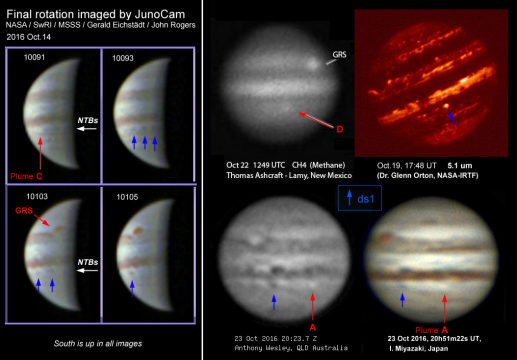Astronomy - Jupiter Returns with a Stormy Surprise
The gas giant Jupiter is emerging in the glow of dawn sporting an tumultuous North Temperate Belt.
Planetary observers getting an early start on Jupiter's 2017-18 apparition are being treated to an outbreak of storms in its North Temperate Belt (NTB). First noticed on October 19th by Glenn Orton using NASA's Infrared Telescope Facility in Hawai'i, a series of bright spots encircling the planet at infrared wavelengths in the NTB heralds a turbulent forecast for the planet as it climbs higher in the pre-dawn sky.

Images of Jupiter's NTB outbreak as captured by multiple amateur and professional instruments. NASA / SwRI / MSSS / Gerald Eichstadt / John Rogers
John Rogers of the British Astronomical Association notes that this type of outbreak occurs at roughly 5-year intervals, and this one was expected to coincide with the planet's conjunction with the Sun. Indeed, Orton's discovery image shows the event was already widespread and had probably began several weeks ago. Intrepid amateurs Anthony Wesley, Phil Miles, Thomas Ashcraft, and Isao Miyazaki have been following the storm's progress at visual and infrared wavelengths, despite the planet's low altitude.
NASA's Juno spacecraft has also spotted tell-tale dark spots along the NTB at visual wavelengths, though due to the orbiter's elliptical polar orbit, it has only recorded low-resolution images so far. Visually, the outbreak appears as a series of dark spots and festoons encircling the planet. More information about the event, as well as what can be expected as it progresses can be found on the BAA website.
Amateur observations of this exciting event are requested in coordination with the Juno mission, and can be uploaded to the Planetary Virtual Observatory & Laboratory after registering on the site. Images can also be shared with the BAA and the Association of Lunar and Planetary Observers (A.L.P.O.).
Jupiter is still quite low in the pre-dawn skies, but climbs higher each day. Observers in the Northern Hemisphere can spot it shortly before dawn low on the eastern horizon.
No comments:
Post a Comment